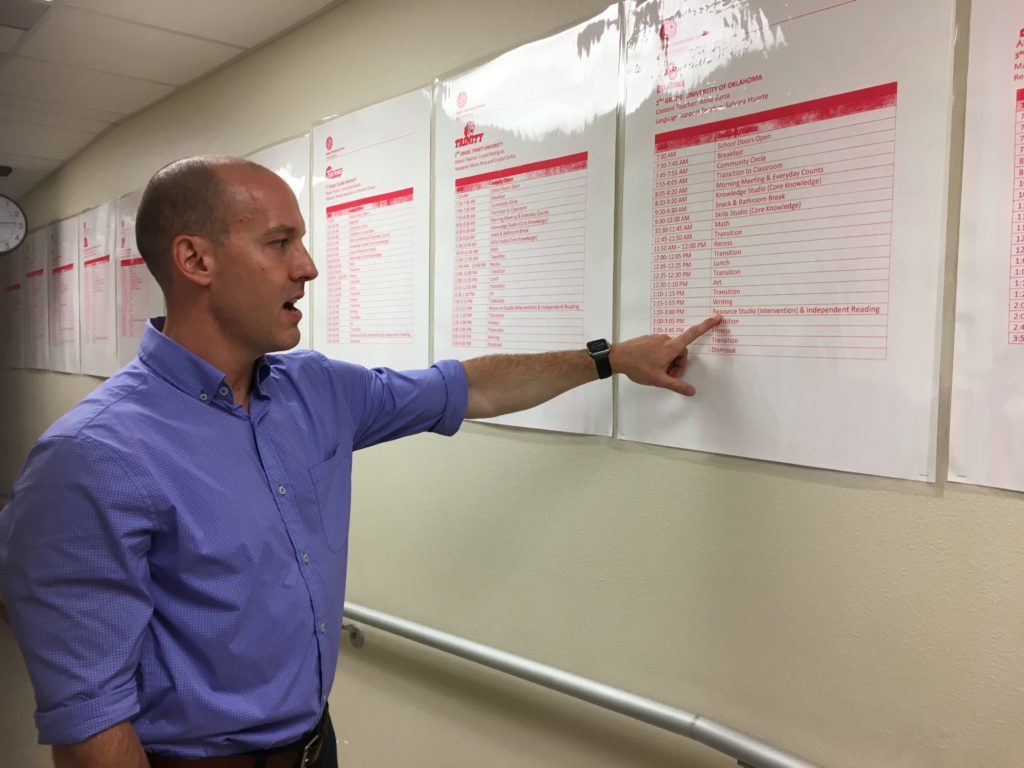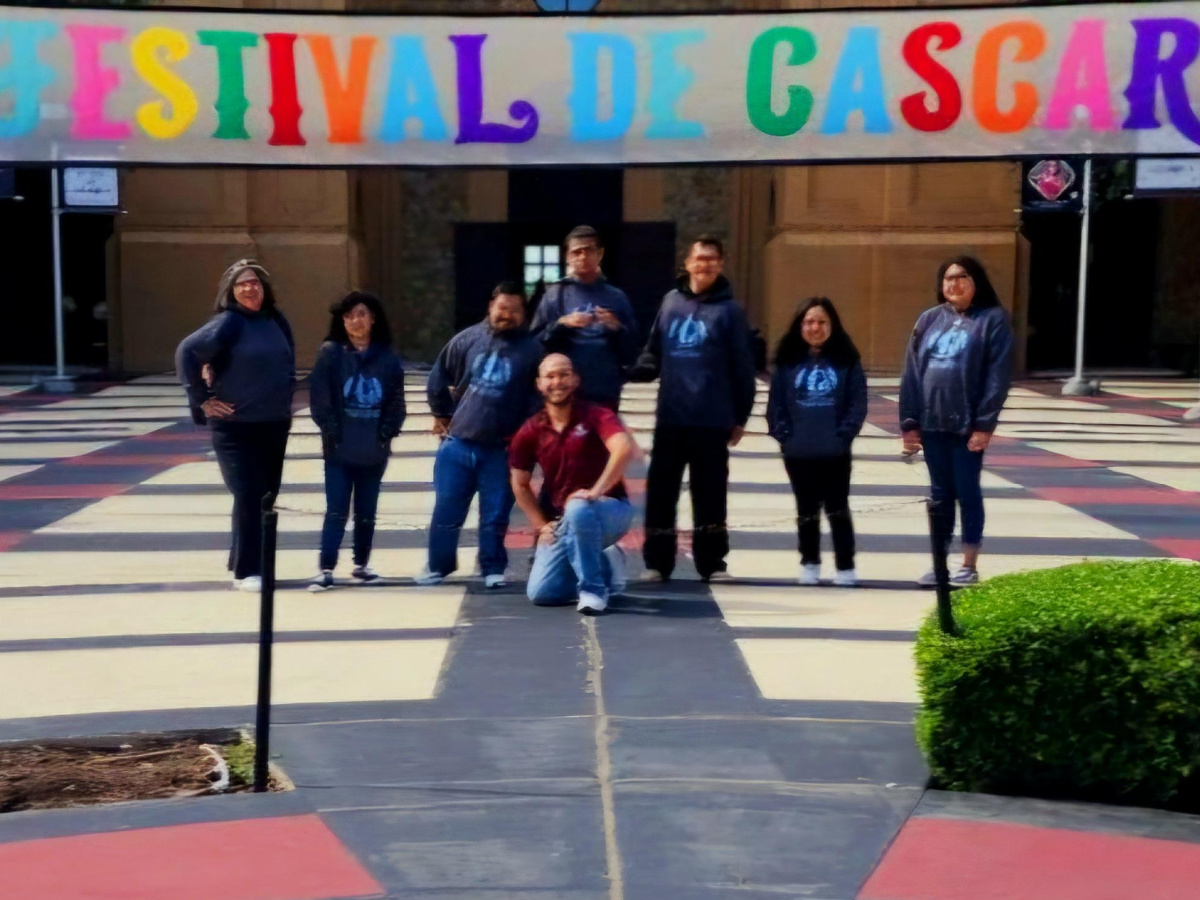Note from SA Charter Moms: We are proud to share guest posts from hallmonitor covering San Antonio’s public schools.

Relay principal fellow Jackie Navar leads community meeting after breakfast at Ogden Elementary
Every one of Ogden Elementary‘s 650 students has free breakfast at school. The littlest kids eat in their class, the primary grades (K–2) eat in the cafeteria, and the older elementary students (grades 3–5) eat in the gym. Everyone eats quietly. Not like, scary quiet, there are murmurs and whispered interactions with teachers, but it’s not the pandemonium one might fear.
When the day starts in an orderly way, Relay Graduate School of Education Executive Director of Teaching and Learning Labs Tim Saintsing says, kids have a solid jumping off point.
And jump off they do.
After breakfast the kids have their community meeting. It’s still pretty orderly, but there are chants, cheers, and a dancing lion mascot to help celebrate their academic achievements. The Scholar of the Week gets a three-tier trophy to keep in his or her classroom for the week. The three classrooms—which are named after colleges—with the highest attendance rates get to perform their class song. The second grade University of Oklahoma actually sings a song with the phrase “boomer sooner” in the chorus.
Before Relay came on campus, Saintsing explained, students had breakfast in their classrooms. This avoided chaos, but it was also a missed opportunity to build campus culture. Relay instituted the community breakfast meetings as one of many opportunities to establish an enthusiasm for learning and growing.
Such chanting will be heard in more cafeterias around the district, beginning with Storm Elementary next year, and possibly more in the future.

Tim Saintsing at Ogden Elementary
The San Antonio ISD board approved a 10-year management agreement with Relay at its April 9 meeting. Relay will officially operate Ogden Elementary and Storm Elementary as a nonprofit called Relay Lab Schools. The new agreement will fall under the 2017 law known as Senate Bill 1882, which incentivizes school districts to form partnerships with charter operators and other nonprofits. On March 19 the district authorized Democracy Prep Charter Schools to operate Stewart Elementary, and on March 26 it authorized Texans Can Academies to run an accelerated program at Highlands High School.
San Antonio Alliance of Teachers and Support Personnel President Shelley Potter has spoken against all three of these partnerships, saying that any private entity taking control of all or part of a public school violates the district’s mission. She did so again on April 9. Potter and other Alliance members have spoken against SAISD Superintendent Pedro Martinez and the board “contracting out” SAISD students to charter schools, which are not truly public schools, Potter says. Most charter schools are run by nonprofit charter management organizations, which can at times be somewhat shadowy when it comes to money and trade secrets.
It is worth noting that as Relay becomes part of the district’s fleet of SB 1882 partnerships, employees will retain their SAISD contracts. This is not the case at Stewart, which drew far more vigorous protests in January and March. Relay is already a familiar face in the district and one that does not have a suspension-heavy disciplinary track record to overcome. It has thus avoided some of scrutiny facing Democracy Prep.
In essence, Relay will be doing more of what they’ve already done this year.

Attendance records for classes at Ogden Elementary
The graduate school of education’s original purpose in SAISD was to help teachers obtain their masters degrees, and to funnel talent into the district by way of one of its most challenging schools. In this first year of the partnership, Ogden has 25 teacher residents, graduate students who work with a mentor teacher in the classroom. One-third of the initial cohort were SAISD employees—permanent substitute teachers, teacher aides, and paraprofessionals—who did not have a pathway into teaching, Saintsing says. Ogden also has two principal fellows, graduate students studying school leadership.
So every classroom has two teachers digging into the lives of individual students, and the school has increased leadership presence. For a school like Ogden, that alone is a huge help, but that’s not all Relay is doing.
Ogden, on the city’s near West Side, had failed to meet state standards for years. With 98 percent of students qualifying as economically disadvantaged, the school is one of the prime examples of concentrated poverty and its effect on schools.
SAISD now hopes that it will become an example of how to overcome those odds.
Relay was born ten years ago, when charter networks KIPP, Achievement First, Uncommon Schools sought to addresses the many teaching needs they saw across their schools. With these parents, school design is really in Relay’s DNA. For instance, while working with Uncommon Schools, Saintsing founded the country’s first all male charter school, Excellence Boys Charter School in Brooklyn’s Bedford-Stuyvesant neighborhood in 2004.
This expertise presented an opportunity for SAISD, and the district asked Relay to get more involved in Ogden.
Ogden’s campus climate is dramatically different than it was pre-Relay, principal fellow Jackie Navar said. She was an assistant principal at Ogden and she’s sold on the Relay Lab Schools model. The breakfast meetings are a snapshot of the overall change she has seen. Discipline referrals have decreased from over 1,000 in 2015–16 to under 500 so far this year. Because they aren’t in the principal’s office, or suspended from school, kids are in class learning. Diagnostic tests indicate that the school is going to see higher standardized testing scores as well.
Students go to school at Ogden from 7:30 A.M. to 4:00 P.M., Monday through Thursday. On Fridays they dismiss at noon, something that required substantial community buy-in. They got it, Saintsing said, because parents realized that teacher quality was essential to their students’ success. Once students go home every Friday, Ogden teachers have a half day of professional development. With the extended hours, students still get more school per year than their peers around the district. Saintsing calculates 16 extra days worth of additional instruction.
Most of those extra hours are spent on literacy.
For younger elementary students, the day includes three hours of literacy, broken into reading, phonics, and writing. They have at least an hour of math, plus fitness and art every day. In the afternoon, the schedule includes an hour for review and extra instruction for kids who might be tripping up on a math concept, struggling with some aspect of literacy, or any other “misconception,” Saintsing explains.
Older elementary students have 80 minutes per day of reading, math, science, and writing. The first 40 minutes are teacher instruction, and the second 40 minutes involves independent work on a Chromebook, allowing students to develop technology skills and self-management disciplines.
Eventually Saintsing said he’d like to see more enrichment and variety in the schedule, but in these years of heavy intervention, the data led them back to the basics.
Seeing the Relay model in action, Navar said she is now “addicted to data.” Once per week she checks in on student performance data, meets with teachers, and strategizes how to intervene where students’ grades are low or dropping. Later that same week she gets another data set, this one she uses to see if the targeted interventions worked. She’s seen student performance metrics jump. While they used to do this once per month, she sees the value in the more frequent check-ins, so that fewer days of instruction go by before teachers intervene.
Navar will complete her Relay program at Ogden and become principal of Storm next year. She’s still learning about the campus particulars, but she already knows that weekly data meetings are part of her plan, along with those morning chants and cheers.
Originally published as “Meet Relay Lab Schools, SAISD’s third partner under SB 1882,” Hall Monitor, April 9, 2018
Read more:
- “[Hall Monitor] Texans Can Academies at Highlands High School: Another Charter Operator to Set Up Shop in San Antonio ISD,” San Antonio Charter Moms, April 27, 2018
- “[Hall Monitor] Stewart Welcomes Democracy Prep to the Neighborhood with Lots of Questions,” San Antonio Charter Moms, April 11, 2018
- “[Hall Monitor] With Democracy Prep, SAISD Is Making New Friends. Can It Keep the Old?,” San Antonio Charter Moms, April 4, 2018
- “[Hall Monitor] Rumblings Continue in the Battle Over SAISD-Charter Partnership,” San Antonio Charter Moms, February 19, 2018










